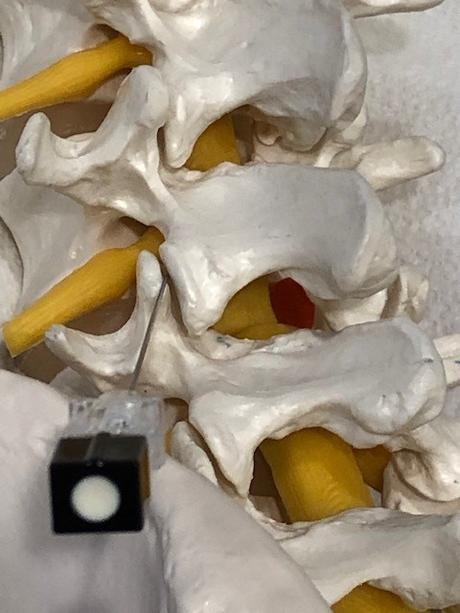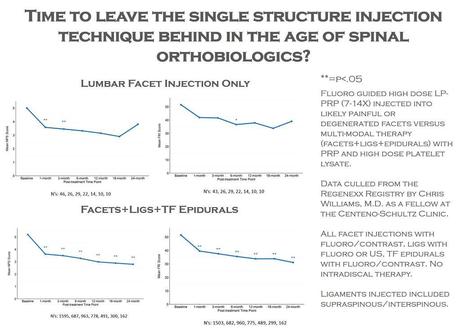Spinal pain can take your breath away and can arise from many different sources. What is a facet joint? What is the role of facet joints? Is a facet joint injection painful? What is a thoracic facet injection? What is a cervical facet injection? Are facet joint injections dangerous? What are the risks of a facet joint injection? What are the complications? Let’s dig in.
Facet Joint Injection
A facet joint injection is a common medical procedure utilized in the diagnosis and treatment of facet joint injuries. It can be performed in the cervical, thoracic, and lumbar spine and may involve one or more facet joints. A facet injection involves the placement of a needle under an x-ray or ultrasound directly into the targeted facet joint and the administration of medication. The injected medicine goes directly into the joint and for this reason, some may refer to a facet injection as an intra-articular facet injection. Intra-articular refers to within the joint.
The procedure can be diagnostic or therapeutic. When diagnostic, a facet joint injection is asking the question of whether the specific facet joint is responsible for a patient’s pain. This is very common in traditional pain practices.
The procedure can also be therapeutic. The medication injected into the facet can reduce inflammation and facilitate healing.
What is a Facet Joint?
The facet joint is a small joint at each level of the cervical, thoracic, and lumbar spine that is located between and behind adjacent vertebrae. They have paired joints with a right and left facet joint at each level of the spine. Like other synovial joints in the body such as the knee, the facet joint has hyaline cartilage and a joint capsule (1). The facet joints are on either side of the midline boney projections called spinous processes. Facet joints are located on the backside of the spine (posterior)
What Do the Facet Joints Do?
The facet joints are important shock absorbers in the posterior portion of the spine. They also limit rotation, and backward bending (extension) and stabilize the spine when bending (2). This a large task for a small joint and as such the joint is susceptible to excessive wear, degeneration, and injury. The facet joint can also be injured by trauma such as a rear-end motor vehicle accident. Facet injury can lead to arthritis in the joint and pain. Lumbar facets are a common source of pain, accounting for 15-45 % of low back pain (3). Facet joint pain in the lumbar spine is commonly localized in the lower back and may involve the buttock and posterior thighs.
Types of Facet Joint Injections

There are different types of facet injections based on the specific area of the spine.
Thoracic Facet Joint Injections (Midback)
Thoracic facet injections are highly skilled injections into the facet joints in the thoracic spine. They are performed under x-ray guidance with the injection of a dye to confirm the accurate placement of both the needle and the medication. Thoracic facet joint injections are difficult due to their steep angle and the surrounding tissue which includes the heart and lungs. An incorrectly placed needle can result in a punctured lung otherwise known as a pneumothorax. This is a medical emergency potentially leading to shortness of breath, elevated heart rate, low blood pressure, and stabbing pain. In many cases, it requires the placement of a chest tube.
Cervical Facet Joint Injections (Neck)
Cervical facet joint injections are injections into the cervical facets. There are 7 cervical facets starting at the area near the base of your skull ( C0/1) and extending down to the lowest cervical segment (C7/T1). Trauma is one of the most common causes of cervical facet injuries. Injuries to the lower cervical facets can refer to the thoracic region. The referral pattern of the cervical facet joint is posted to the right.
Lumbar Facet Joint Injections (Lower Back)
Lumbar facet injections are injections into the lumbar facet joints. There are 5 paired lumbar facet joints. For example, there is a right and left L5/S1 facet joint. Trauma such as a rear-end motor vehicle injury is a common cause of lumbar facet injuries. Injury to the facet joint can lead to post-traumatic arthritis.
Is a Facet Joint Injection Painful?
Pain varies from patient to patient. Facet injections should be performed under intermittent x-ray guidance where contrast can confirm the appropriate needle placement. The injection can be performed with or without IV sedation depending upon the preference of the patient and provider. When performed without sedation the skin and subcutaneous layers are injected with numbing medication. Other factors that may influence the level of pain during a facet joint injection include the size of the needle, the amount of tissue between the skin and the joint, the physician’s experience, and the severity of spinal pain prior to the injection.
Is a Facet Joint Injection Dangerous?
Facet injections are one of the treatment options for neck, thoracic, and low back pain that has not responded to conservative care (4). Injections directly into the joint (intra-articular) and medial branch blocks are the most common injections performed ( 5). All injections have inherent risks and possible complications. These include bleeding, infection, failure, escalation in pain, nerve damage, and reduction in heart rate (6). Medications injected include local anesthetic and steroids. Steroids are very dangerous as they are toxic to joint cartilage (7), your body’s stem cells (8), and negatively impact your stress management hormones (9).
What are the Risks of Facet Joint Injection?
The major risks associated with facet joint injections are bleeding, infection, transient increase in pain, injury to a nerve or blood vessel, and failure. X-ray or ultrasound guidance is critical to ensure the accurate placement of the needle and injected medication. A special dye called contrast is used to confirm that the needle is within the joint (intra-articular) and NOT in a blood vessel or nerve. Thoracic facet injections require additional skill and training due to the complexity of the anatomy.
What are the Complications of Facet Joint Injections?
There are a number of complications from facet joint injections which include:
Infection
Infection may involve muscle, tendon, ligament, facet joint, epidural space, and bone. Bone infection is a serious medical condition that requires antibiotic therapy and in many cases surgery. Infection in the facet joint can damage the facet joint cartilage lining resulting in painful arthritis of the joint.
Pain
Pain can arise due to needle placement and irritation of the muscles, tendons, ligaments, and facet capsules. The pain is typically transient in nature.
Nerve Injury
The needle used in the facet joint injection may contact and injury a nerve. This can cause damage to the nerve with resultant pain. The pain may be mild to severe depending on the extent of the nerve damage. The use of x-ray and ultrasound guidance during facet joint injections minimizes the risk of nerve injury. This is the standard of care at the Centeno-Schultz Clinic.
Collapsed Lung
Puncture and collapse of a lung are one of the specific complications associated with thoracic facet injections. The lung is in close proximity to both the thoracic facet and the costovertebral joint. X-ray guidance, extensive experience, and advanced training can minimize the risk of this complication.
Regenerative Treatment Options
PRP is an effective steroid alternative in the treatment of facet pain (10). PRP is rich in growth factors that can reduce inflammation and promote healing without the toxic side effects of steroids. Blood is obtained typically from the arm, processed to concentrate the growth factors, and reinjected into the facet joint.
Clinical Approach for Best Outcomes
For patients to get the very best clinical results, physicians need to change their clinical approach. At the Centeno-Schultz Clinic, we acknowledge that each of the 24 levels in the cervical, thoracic and lumbar spine are more than just single parts but rather act as one machine. This machine is called the functional spinal unit (FSU) which is compromised of multiple parts which include the disc, facet joints, ligaments, bones, and muscles. Each of these is critical in providing stability to the spine. To learn more about the different parts and their role please click on the video below.
Unfortunately, most pain and regenerative medicine clinics focus exclusively on identifying your “pain generator”. In this model, the doctor identifies one structure in the spine thought to be causing the pain.
For example, a physician may identify your facet as your ” pain generator” and as such direct all treatment toward the facet joint. This model is flawed and does not acknowledge that all the different parts of the spine work together as demonstrated in the FSU model. Most importantly it does not provide the best clinical outcome.
At the Centeno-Schultz Clinic, we utilize the FSU model and as such inject multiple structures in the spine during a single treatment to provide the best outcome. The graph below illustrates how treating multiple areas affords a better outcome. In the graphs below the pain, score is on the vertical axis and time is on the horizontal axis.
The top two graphs demonstrate the reduction in pain at different time points when injecting only the lumbar facet joints. The two graphs on the bottom demonstrate that by injecting the lumbar facets plus spinal ligaments and the epidural space, patients had more pain relief. Acknowledging that there are multiple important parts is critical and a core tenant at the Centeno-Schultz Clinic.

To better understand the complexity and attention to detail required for a facet injection please click on the video below.
In Conclusion
The facet joint is a pair of cartilage-lined joints at each level of the spinal that provide important stability and resist excessive rotation and extension. They are susceptible to injury and degeneration which can cause pain. Facet injections are used when conservative therapy has failed. There are three types of facet injections: cervical, thoracic, and lumbar (neck, mid-back and low back). The major complications of a facet injection include infection, pain, nerve and nerve injury.
A Facet joint injection is performed under x-ray guidance and may be associated with discomfort depending upon a number of factors. Bleeding, infection, escalation in pain, and failure are the most common risks. Injected steroids are dangerous as they are toxic to cartilage and one’s repair cells. PRP is effective in the treatment of facet injuries. Clinical outcomes improve when the spine is viewed and treated as a functional unit. Learn more about this and other back surgery alternatives.
References ——————————————
1. Yahia LH, Garzon S. Structure on the capsular ligaments of the facet joints. Ann Anat. 1993;175(2):185–188.DOI: 10.1016/s0940-9602(11)80179-2
2.The mechanical function of the lumbar apophyseal joints. Adams MA, Hutton WC. Spine (Phila Pa 1976). 1983 Apr; 8(3):327-30.DOI: 10.1097/00007632-198304000-00017
3.Perolat R, Kastler A, Nicot B, et al. Facet joint syndrome: from diagnosis to interventional management. Insights Imaging. 2018;9(5):773-89. doi: 10.1007/s13244-018-0638-x
4.Filippiadis DK, Kelekis A. A review of percutaneous techniques for low back pain and neuralgia: current trends in epidural infiltrations, intervertebral disk and facet joint therapies. Br J Radiol. 2016;89(1057):20150357. DOI: 10.1259/bjr.20150357.
5.Dreyfuss PH, Dreyer SJ, Herring SA. Lumbar zygapophysial (facet) joint injections. Spine. 1995;20(18):2040-7.DOI: 10.1097/00007632-199509150-00019.
6.Velickovic M, Ballhause TM. Delayed onset of a spinal epidural hematoma after facet joint injection. SAGE Open Med Case Rep. 2016;4:2050313X16675258. DOI: 10.1177/2050313X16675258.
7.Wernecke C, Braun HJ, Dragoo JL. The Effect of Intra-articular Corticosteroids on Articular Cartilage: A Systematic Review. Orthop J Sports Med. 2015;3(5):2325967115581163.doi: 10.1177/2325967115581163.
8.Shao J, Xu X, Li G, et al. Inhibitory effects of pharmacological doses of dexamethasone on mineralization of mesenchymal progenitor cells in vitro. Pharmazie. 2009;64(10):674-9.
9.Chon JY, Moon HS. Salivary cortisol concentration changes after epidural steroid injection. Pain Physician. 2012;15(6):461-6.
10.Wu J, Du Z, Lv Y, et al. A New Technique for the Treatment of Lumbar Facet Joint Syndrome Using Intra-articular Injection with Autologous Platelet Rich Plasma. Pain Physician. 2016;19(8):617-25.

